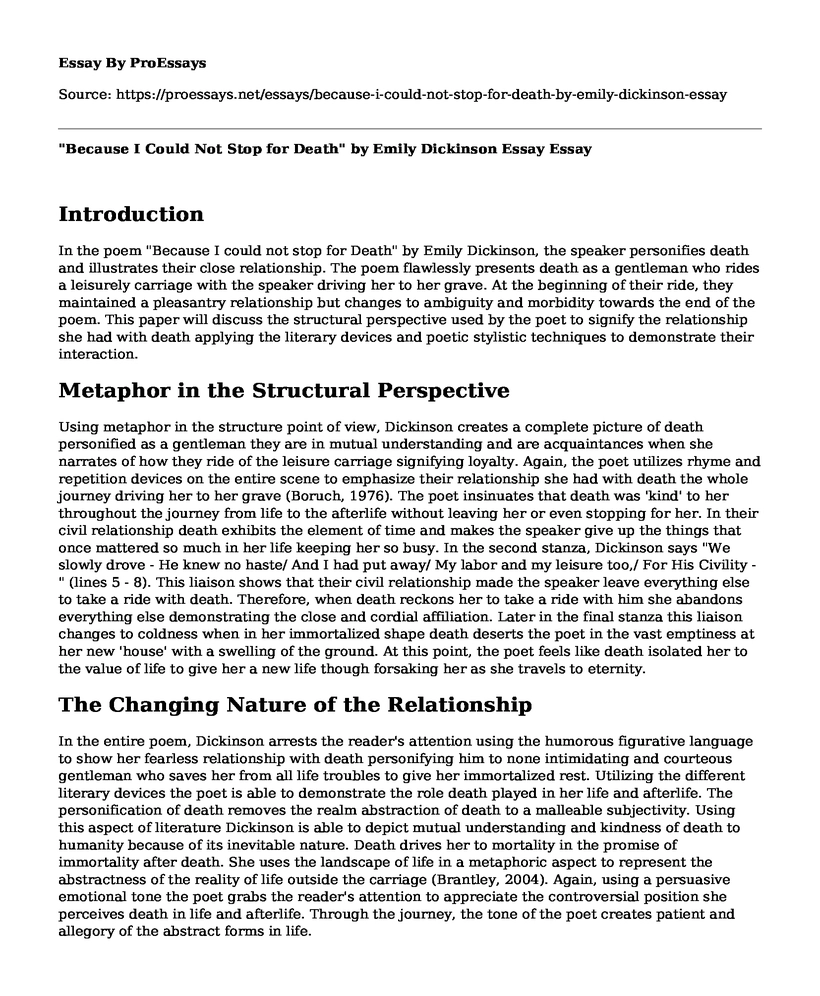Introduction
In the poem "Because I could not stop for Death" by Emily Dickinson, the speaker personifies death and illustrates their close relationship. The poem flawlessly presents death as a gentleman who rides a leisurely carriage with the speaker driving her to her grave. At the beginning of their ride, they maintained a pleasantry relationship but changes to ambiguity and morbidity towards the end of the poem. This paper will discuss the structural perspective used by the poet to signify the relationship she had with death applying the literary devices and poetic stylistic techniques to demonstrate their interaction.
Metaphor in the Structural Perspective
Using metaphor in the structure point of view, Dickinson creates a complete picture of death personified as a gentleman they are in mutual understanding and are acquaintances when she narrates of how they ride of the leisure carriage signifying loyalty. Again, the poet utilizes rhyme and repetition devices on the entire scene to emphasize their relationship she had with death the whole journey driving her to her grave (Boruch, 1976). The poet insinuates that death was 'kind' to her throughout the journey from life to the afterlife without leaving her or even stopping for her. In their civil relationship death exhibits the element of time and makes the speaker give up the things that once mattered so much in her life keeping her so busy. In the second stanza, Dickinson says "We slowly drove - He knew no haste/ And I had put away/ My labor and my leisure too,/ For His Civility -" (lines 5 - 8). This liaison shows that their civil relationship made the speaker leave everything else to take a ride with death. Therefore, when death reckons her to take a ride with him she abandons everything else demonstrating the close and cordial affiliation. Later in the final stanza this liaison changes to coldness when in her immortalized shape death deserts the poet in the vast emptiness at her new 'house' with a swelling of the ground. At this point, the poet feels like death isolated her to the value of life to give her a new life though forsaking her as she travels to eternity.
The Changing Nature of the Relationship
In the entire poem, Dickinson arrests the reader's attention using the humorous figurative language to show her fearless relationship with death personifying him to none intimidating and courteous gentleman who saves her from all life troubles to give her immortalized rest. Utilizing the different literary devices the poet is able to demonstrate the role death played in her life and afterlife. The personification of death removes the realm abstraction of death to a malleable subjectivity. Using this aspect of literature Dickinson is able to depict mutual understanding and kindness of death to humanity because of its inevitable nature. Death drives her to mortality in the promise of immortality after death. She uses the landscape of life in a metaphoric aspect to represent the abstractness of the reality of life outside the carriage (Brantley, 2004). Again, using a persuasive emotional tone the poet grabs the reader's attention to appreciate the controversial position she perceives death in life and afterlife. Through the journey, the tone of the poet creates patient and allegory of the abstract forms in life.
Using these different forms of poetic stylistic techniques and literary devices the poet is able to communicate to her audience on sensitive social matters without giving the subject abstractness. Her appreciation of death makes a wakeup call to her audience to understand the concept of mortality. In her passion description of death Dickinson makes a contemporary approach to reckoning humanity to appreciate life.
References
Boruch, Marianne. "Dickinson Descending." The Georgia Review 40 (1986): 863-877.
Brantley, Richard E. (2004). Experience and Faith: The Late-Romantic Imagination of Emily Dickinson. New York: Palgrave Macmillan.
Cite this page
"Because I Could Not Stop for Death" by Emily Dickinson Essay. (2022, Jul 03). Retrieved from https://proessays.net/essays/because-i-could-not-stop-for-death-by-emily-dickinson-essay
If you are the original author of this essay and no longer wish to have it published on the ProEssays website, please click below to request its removal:
- Characters of Antigone in "Antigone" and Nora in "A Doll's House" Essay
- Race in To Kill a Mockingbird Essay Example
- Critical Analysis of the Short Story "Salvage" Essay Example
- Analysis of the Song Another Brick in the Wall Paper Example
- Literary Analysis Essay on Class Separation in the Great Gatsby
- Don Quixote - Literary Analysis Essay
- Essay Example on Fahrenheit 451: Exploring Irony and Its Impact







